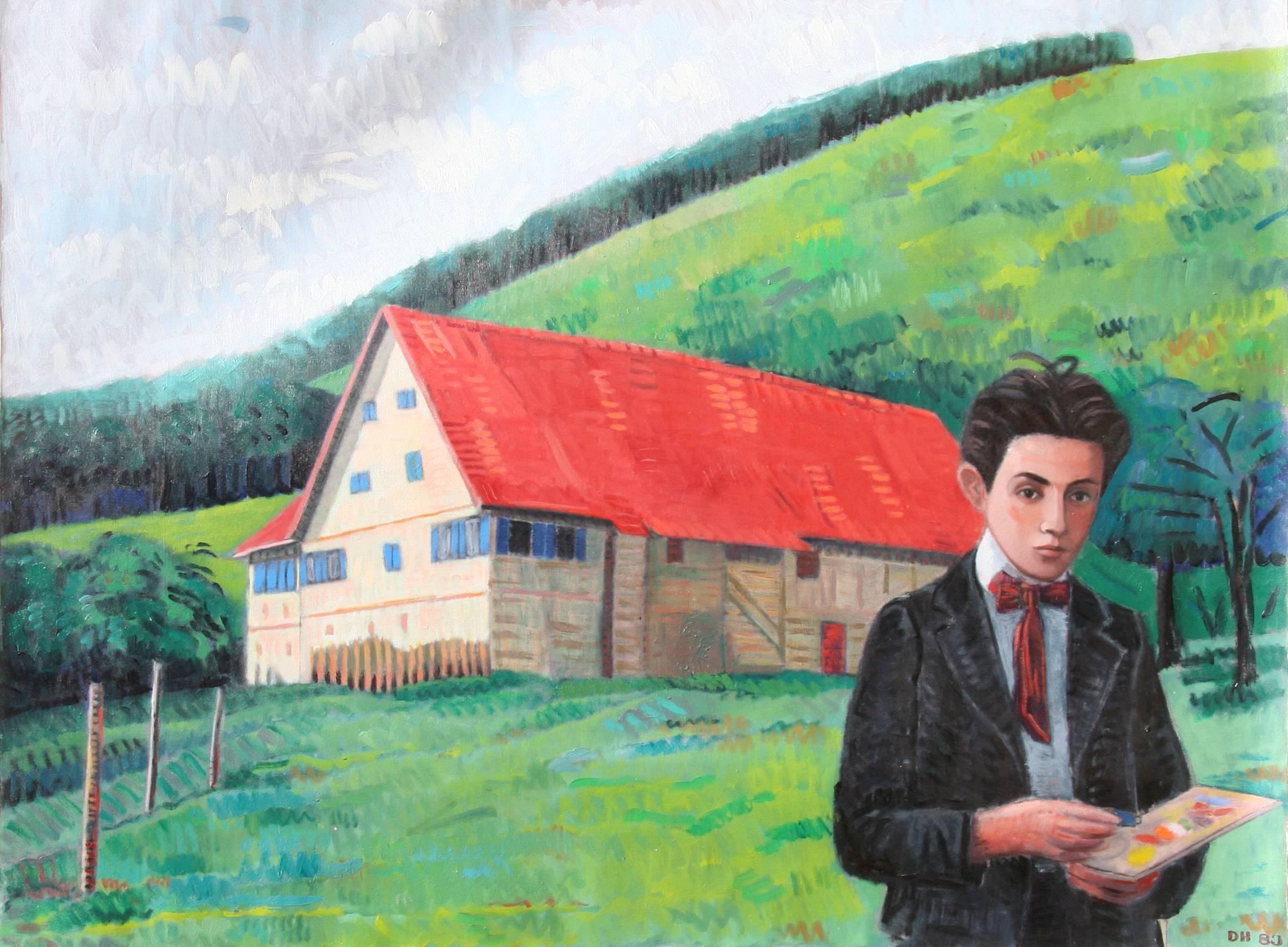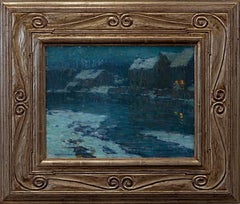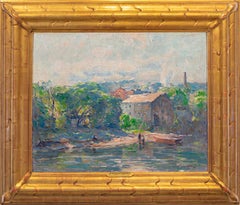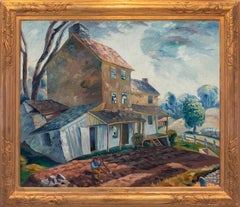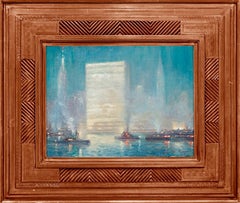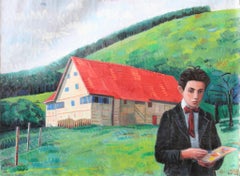Items Similar to "Winter Storm, NYC"
Want more images or videos?
Request additional images or videos from the seller
1 of 7
Johann Berthelsen, 1883-1972"Winter Storm, NYC"
About the Item
Jim’s of Lambertville Fine Art Gallery is proud to offer this piece by Johann Berthelsen (1883 – 1972).
Born in 1883 in Denmark to artistically inclined parents, Johann Berthelsen would become a widely successful singer, teacher, and painter. After his parents divorced, his mother brought Berthelsen and his siblings with her to the United States in 1890, eventually settling in Wisconsin.
At eighteen, Berthelsen moved to Chicago in the hope of becoming an actor, but a friend at the Chicago Musical College convinced him to audition at his school. Berthelsen received a full scholarship and enrolled at the college, where he was awarded the Gold Medal twice. After graduating, he had an active career traveling across the United States and Canada performing in operas and concerts, before joining the voice faculty at his alma mater in 1910. In 1913, Berthelsen became the voice department director at the Indianapolis Conservatory of Music.
While in Chicago, Berthelsen met the landscape painter, Svend Svendsen, whose depictions of winter scenes sparked an interest in painting for Berthelsen. After moving to Indianapolis, he befriended the painter, Wayman Adams, who had studied under William Merritt Chase and Robert Henri. The two moved to New York together in 1920 to pursue new artistic opportunities.
While in New York, Bethelsen founded a school for singing instruction at the Rodin Studios. In his spare time, Berthelsen began depicting New York in pastel and watercolor, which received positive reviews when he exhibited. In 1926, he received a membership to the American Watercolor Society.
With the initiation of the Depression, Berthelsen could no longer provide for his family as a singer or teacher. He began to use oil paint rather than pastel, selling his work in galleries to be able to afford the minimal groceries necessary to keep his family from starving. As his talent became further recognized in New York, Berthelsen began working in various New Deal projects in the mid-1930s.
As WWII came to a close, and with it newfound post-war prosperity, the public became once again enthralled with the arts. The demand for Berthelsen's works increased, allowing for the family to return to more comfortable living arrangements.
Berthelsen died in 1972 after increasingly declining health following a car accident the year before.
- Creator:Johann Berthelsen, 1883-1972 (1883 - 1972, American)
- Dimensions:Height: 20 in (50.8 cm)Width: 24 in (60.96 cm)
- More Editions & Sizes:Framed Size 28" x 32"Price: $46,875
- Medium:
- Movement & Style:
- Period:
- Condition:
- Gallery Location:Lambertville, NJ
- Reference Number:Seller: PB1214160421stDibs: LU3745489412
Johann Berthelsen, 1883-1972
Johann Berthelsen was born in Copenhagen, Denmark, on July 25, 1883. He was a member of the Salmagundi Club, American Watercolor Society, and Allied Artists of America. He exhibited widely and was the recipient of numerous awards including the Erskine Prize in 1928 in Chicago and 1946, in Indianapolis, the Holcombe M. Austin Prize. Known for his scenes of city streets in New York, he usually did paintings in pairs and is best known for his New York winter scenes.
About the Seller
5.0
Vetted Seller
These experienced sellers undergo a comprehensive evaluation by our team of in-house experts.
Established in 1997
1stDibs seller since 2014
36 sales on 1stDibs
Typical response time: 4 hours
- ShippingRetrieving quote...Ships From: Lambertville, NJ
- Return PolicyThis item cannot be returned.
Authenticity Guarantee
In the unlikely event there’s an issue with an item’s authenticity, contact us within 1 year for a full refund. DetailsMoney-Back Guarantee
If your item is not as described, is damaged in transit, or does not arrive, contact us within 7 days for a full refund. Details24-Hour Cancellation
You have a 24-hour grace period in which to reconsider your purchase, with no questions asked.Vetted Professional Sellers
Our world-class sellers must adhere to strict standards for service and quality, maintaining the integrity of our listings.Price-Match Guarantee
If you find that a seller listed the same item for a lower price elsewhere, we’ll match it.Trusted Global Delivery
Our best-in-class carrier network provides specialized shipping options worldwide, including custom delivery.More From This Seller
View All"The Shepaug"
By John Fulton Folinsbee
Located in Lambertville, NJ
Jim's of Lambertville Fine Art Gallery is proud to present this piece by John Fulton Folinsbee (1892 - 1972).
One of the finest painters to embark upon the New Hope Art Colony, John...
Category
1910s American Impressionist Landscape Paintings
Materials
Canvas, Oil
"Shad Fisherman"
By John Fulton Folinsbee
Located in Lambertville, NJ
Jim's of Lambertville Fine Art Gallery is proud to present this piece by John Fulton Folinsbee (1892 - 1972).
One of the finest painters to embark upon the New Hope Art Colony, John...
Category
1920s American Impressionist Landscape Paintings
Materials
Oil, Canvas
"House on the Hill, Stockton"
By Richard Wedderspoon
Located in Lambertville, NJ
Jim's of Lambertville Fine Art Gallery is proud to present this piece by Richard Wedderspoon (1889 - 1976).
Richard Wedderspoon was an important member of the New Hope Art Colony as both an Impressionist and Modernist painter. Wedderspoon was not only a respected painter, but also a teacher who spent summers at his Bucks County home and the school year at Syracuse University where he was Professor of painting. He was born in Red Bank, New Jersey and first studied art at the Carnegie Institute in Pittsburgh. He continued his studies at the Corcoran School of Art in Washington, and at age twenty four, he enrolled at the Pennsylvania Academy of the Fine Arts studying with Henry McCarter and Daniel Garber. While there his roommates were Charles Garner and Lloyd Ney. Wedderspoon began friendships with fellow artists, Charles Hargens, Clarence Johnson and Stanley Reckless...
Category
1930s American Impressionist Landscape Paintings
Materials
Oil, Canvas
"New York Harbor"
By Johann Berthelsen, 1883-1972
Located in Lambertville, NJ
Jim’s of Lambertville Fine Art Gallery is proud to offer this piece by Johann Berthelsen (1883 – 1972).
Born in 1883 in Denmark to artistically inclined parents, Johann Berthelsen would become a widely successful singer, teacher, and painter. After his parents divorced, his mother brought Berthelsen and his siblings with her to the United States in 1890, eventually settling in Wisconsin.
At eighteen, Berthelsen moved to Chicago in the hope of becoming an actor, but a friend at the Chicago Musical College convinced him to audition at his school. Berthelsen received a full scholarship and enrolled at the college, where he was awarded the Gold Medal twice. After graduating, he had an active career traveling across the United States and Canada performing in operas and concerts, before joining the voice faculty at his alma mater in 1910. In 1913, Berthelsen became the voice department director at the Indianapolis Conservatory of Music.
While in Chicago, Berthelsen met the landscape painter, Svend Svendsen...
Category
20th Century American Impressionist Landscape Paintings
Materials
Oil, Canvas
"Road to Argus"
By Walter Emerson Baum
Located in Lambertville, NJ
Jim’s of Lambertville Fine Art Gallery is proud to offer this piece by Walter Emerson Baum (1884 - 1956).
Born in Sellersville, Pennsylvania, Walter Baum was one of the only members...
Category
1930s American Impressionist Landscape Paintings
Materials
Oil, Canvas
"The Gossips"
By Richard Wedderspoon
Located in Lambertville, NJ
Jim's of Lambertville Fine Art Gallery is proud to present this piece by Richard Wedderspoon (1889 - 1976).
Richard Wedderspoon was an important member of the New Hope Art Colony as both an Impressionist and Modernist painter. Wedderspoon was not only a respected painter, but also a teacher who spent summers at his Bucks County home and the school year at Syracuse University where he was Professor of painting. He was born in Red Bank, New Jersey and first studied art at the Carnegie Institute in Pittsburgh. He continued his studies at the Corcoran School of Art in Washington, and at age twenty four, he enrolled at the Pennsylvania Academy of the Fine Arts studying with Henry McCarter and Daniel Garber. While there his roommates were Charles Garner and Lloyd Ney. Wedderspoon began friendships with fellow artists, Charles Hargens, Clarence Johnson and Stanley Reckless...
Category
1940s American Impressionist Landscape Paintings
Materials
Oil, Canvas
You May Also Like
Early 20th Century Yosemite Winter Park Landscape
By William Lemos
Located in Soquel, CA
Beautiful large scale landscape of Yosemite with Half Dome and El Capitan above the Merced River by William Lemos (American, 1861-1942). Rendered in cool grays and blues, Half Dome r...
Category
1910s American Impressionist Landscape Paintings
Materials
Canvas, Oil
$1,760 Sale Price
20% Off
Golf Course, Probably The Country Club, Brookline MA
By Arthur Clifton Goodwin
Located in Milford, NH
A fine landscape of a golf course, probably The Country Club, Brookline, MA by American artist Arthur Clifton Goodwin (1864-1929). Born in Portsmouth, New Hampshire, Goodwin lived an...
Category
Early 20th Century American Impressionist Landscape Paintings
Materials
Canvas, Oil
Telepathy, Oil Painting by Duncan Hannah
By Duncan Hannah
Located in Long Island City, NY
Artist: Duncan Hannah, American (1952 - )
Title: Telepathy
Year: 1983
Medium: Oil on Canvas, signed and dated
Size: 44 in. x 58 in. (111.76 cm x 147.32 cm)
Category
1980s American Impressionist Landscape Paintings
Materials
Canvas, Oil
Price Upon Request
On The Dunes Near Provincetown
By Nellie Augusta Knopf
Located in Milford, NH
A fine impressionist landscape oil painting by American artist Nellie Augusta Knopf (1875-1962). Knopf was born in Chicago, IL, and studied art at the Art Institute of Chicago where she studied under John Vanderpoel and Frederick Free...
Category
Early 20th Century American Impressionist Landscape Paintings
Materials
Canvas, Oil
Pair of Birds
By Abbott Handerson Thayer
Located in Milford, NH
A fine woodland scene oil painting with two birds by American artist Abbott Handerson Thayer (1849-1921). Thayer was born in Boston to a prominent family and attended the Chauncey Hall School, founded by his grandfather. His art teacher there was Henry Morse from whom he learned to do animal portraits. He studied at the Brooklyn Academy of Design with Lemuel Wilmarth, and after marrying Kate Bloede, he went to Paris for a year, as a student of Jean Leon Gerome. In 1879, he opened a studio in Brooklyn in the same building as the studios of Thomas Dewing...
Category
Late 19th Century American Impressionist Animal Paintings
Materials
Canvas, Oil
On The Fence
By John Rutherford Boyd
Located in Milford, NH
A fine impressionist oil painting of a woman sitting near a fence by American artist John Rutherford Boyd (1884-1951). Boyd was born in Philadelphia, PA, and attended the Pennsylvania Academy of Fine Arts, where he studied under American painter Thomas Anshutz...
Category
Early 1900s American Impressionist Figurative Paintings
Materials
Canvas, Oil


